When it comes to Mediterranean cuisine, few countries can rival the culinary treasures and delicious food of Greece. From its ancient food traditions to its vibrant modern dining scene, Greece offers an irresistible journey of flavours that tell stories of culture, history, and community.
Whether you’re trying a traditional Greek salad or a modern variation, you’re experiencing the essence of Greek cuisine: delicious, fresh, and uncomplicated.
If you’re a traveller searching for an authentic gastronomic experience, the dishes of Greece are sure to captivate your taste buds. No matter where you are – travelling bustling cities or quaint island villages –, Greek food is a feast for both the senses and the soul. Exploring authentic Greek cuisine promises a journey of unforgettable flavours.
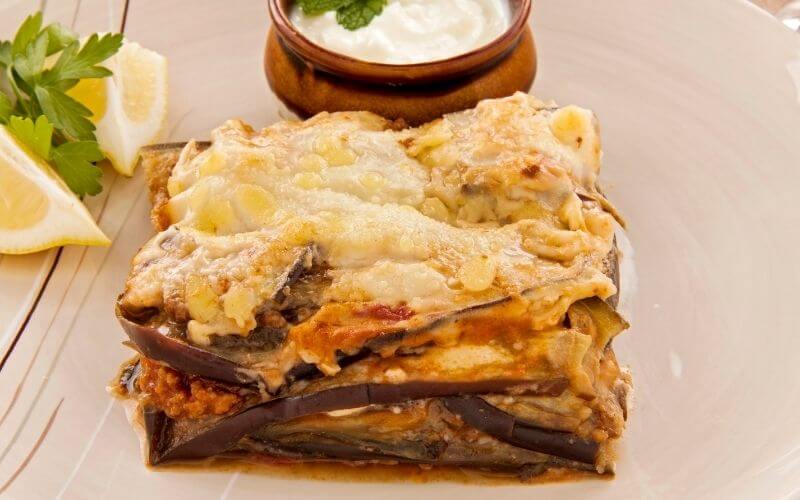
Greek food is deeply rooted in tradition, with recipes passed down through generations. The dishes have been influenced by various cultures, including the Romans, Ottomans, and Middle Eastern countries, resulting in a unique blend of flavours and aromas. At its heart are fresh, simple ingredients that celebrate the Mediterranean way of life. Here are some of the best Greek foods that you simply must try:
Moussaka and Other Casseroles
Grilled Meats and Seafood
Souvlaki and Gyros: These beloved street foods feature skewered meat or shaved slices of pork or chicken wrapped in warm pita bread, often served with tzatziki sauce.
Spanakopita: A flaky pastry filled with spinach, feta cheese, and herbs, this savory pie captures the essence of Greek traditional food.
Dolmades: Grape leaves stuffed with rice, herbs, and sometimes minced meat, these bites are perfect as part of a mezze platter.
Greek Salad: The Greek salad is a classic dish that embodies the simplicity and freshness of Greek cuisine. Known locally as horiatiki, this refreshing dish combines ripe tomatoes, cucumbers, olives, and a generous slab of feta cheese, all drizzled with olive oil.
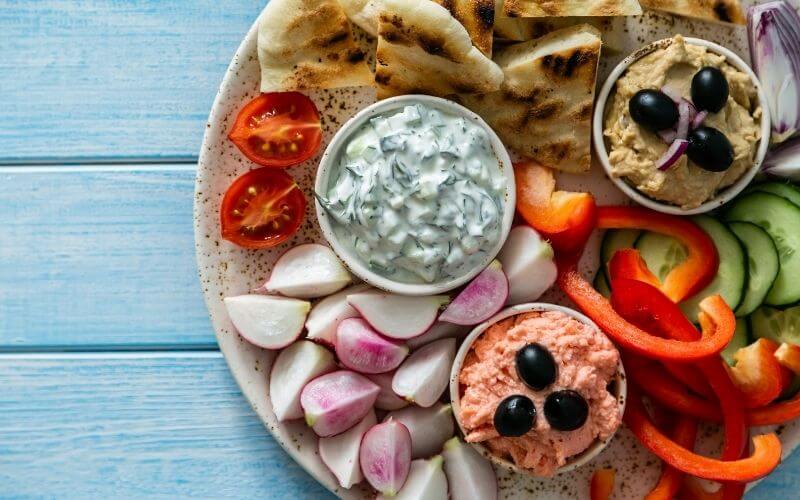
Appetizers and small plates are an essential part of Greek cuisine. Some popular options include tzatziki sauce, a classic Greek dip made with yogurt, cucumbers, and garlic, often served with pita bread. Another favourite is grilled octopus, which is often served with a squeeze of fresh lemon juice and a side of rich tomato sauce.
Greek salad is also a staple, featuring juicy tomatoes, cucumbers, red onions, feta cheese, and kalamata olives, all dressed with extra virgin olive oil. Spinach pie and cheese pie are also popular options, made with phyllo dough and filled with spinach and feta cheese or a variety of cheeses. For cheese lovers, saganaki is a must-try, a fried cheese dish often served with a squeeze of fresh lemon juice.
Tzatziki is a classic Greek dip made with yogurt, cucumbers, garlic, and dill.
Fava is a traditional Greek dip made with yellow split peas, garlic, and lemon juice.
Taramosalata is a Greek fish roe dip made with fish roe, lemon juice, garlic, and olive oil.
Kolokithokeftedes are fried zucchini balls flavored with feta cheese, salt, and fresh mint.
Tomatokeftedes are fried tomato balls made with grated tomatoes, onions, egg, and breadcrumbs.
Cheese saganaki is a fried cheese dish made with feta cheese, breadcrumbs, and olive oil.
Gemista is a traditional Greek dish made with stuffed vegetables, typically tomatoes and green bell peppers. The filling is made with a mix of rice, onions, olive oil, and spearmint.
There are two versions of gemista: the meat-free version and the version with minced meat.

Greek desserts and sweets are known for their sweetness and richness. Some popular options include baklava, a classic Greek dessert made with layers of phyllo dough, nuts, and honey syrup. Galaktoboureko is another favourite, a semolina custard pie wrapped in phyllo dough and topped with a sweet syrup.
Greek yogurt with honey is also a popular dessert, featuring thick and creamy yogurt topped with a drizzle of honey. Spoon sweets are another traditional Greek dessert, made with fresh fruits and nuts cooked in a sugar syrup.
Baklava is a popular Greek dessert made with layers of phyllo dough and nuts, and topped with honey.
Galaktoboureko is a Greek dessert made with semolina custard and phyllo dough.
Loukoumades are Greek doughnuts made with fried dough balls and topped with honey and walnuts.
Good to know: For a classic Greek treat, try a traditional Greek coffee, made with finely ground coffee beans and served in a small cup.
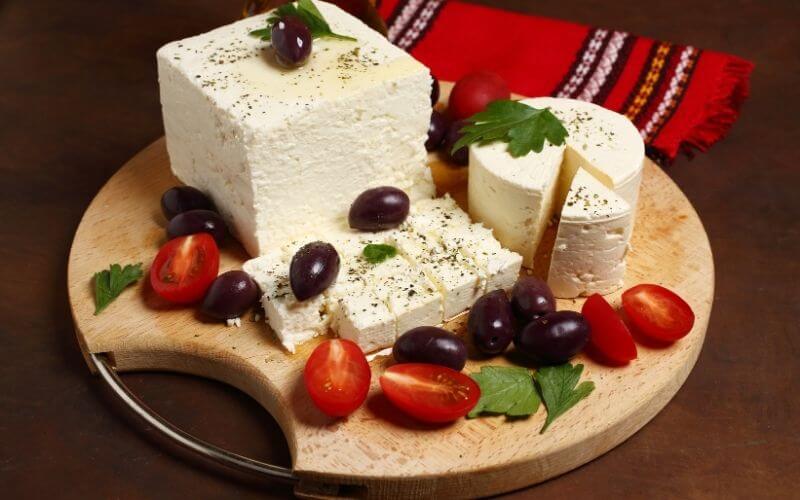
The magic of Greek food lies in its simplicity, with fresh ingredients and high-quality components forming the foundation of every dish. These staples are not only essential to the dishes of Greece but also reflect the country’s geography, climate, and traditions.
Known as “liquid gold,” olive oil is the cornerstone of Greek cuisine. It’s used in everything from salads to stews, lending a rich and fruity flavour to dishes. Greece is one of the world’s top producers of olive oil, with the Peloponnese and Crete being famous for their exceptional varieties.
Feta, Greece’s most famous cheese, is made from sheep’s milk or a blend of sheep and goat’s milk. Salty and tangy, it’s a key ingredient in dishes like Greek salad, spanakopita, and pies. Its Protected Designation of Origin (PDO) status ensures its authenticity.
Greek cooking relies on herbs like oregano, thyme, dill, and parsley to enhance its flavours. These herbs are often grown wild in the country’s mountainous regions, adding an earthy aroma to many recipes.

With its extensive coastline, Greece boasts an abundance of fresh seafood. Fish like sea bream, octopus, and squid play a starring role in island cuisine, often grilled or cooked in simple yet flavourful sauces.
Tomatoes, eggplants, zucchini, and green bell peppers are staples in Greek cooking. These vegetables, often sun-ripened and locally sourced, appear in dishes like briam (a roasted vegetable medley) and stuffed peppers (gemista). Green bell peppers, in particular, are ideal for stuffing and enhance the fresh and colorful mix of ingredients in Greek Salad.
Lentils, chickpeas, and beans have been dietary staples in Greece since ancient times. They’re used in soups, salads, and stews, providing protein and heartiness to meals. Barley and wheat are also central to dishes like dakos and traditional bread.
Greek honey, derived from thyme, pine, or wildflowers, is revered for its complex taste. It’s used in desserts like baklava and loukoumades and even paired with yoghurt for a simple yet divine treat.
These ingredients are not just components of Greek cuisine—they are symbols of the country’s deep connection to the land and sea. For travellers, savouring dishes made with these staples offers a taste of Greece’s culinary heritage.

Greek beverages are an essential part of the country’s cuisine. Some popular options include ouzo, a strong anise-flavored spirit often served as an aperitif or digestif. Greek coffee is also a staple, made with finely ground coffee beans and served in a small cup.
For a refreshing drink, try a glass of freshly squeezed lemonade, made with real lemons and sugar. Greek wine is also a popular option, featuring a variety of red and white wines made from indigenous grape varieties. For a traditional Greek drink, try a glass of frappé, a cold coffee drink made with instant coffee, sugar, and water.
Coffee and Frappé
Greek coffee is a type of coffee made with finely ground coffee beans and sugar.
Frappé is a traditional Greek iced coffee beverage made with instant coffee, ice cubes, and cold water.
Ouzo and Retsina Wine
Ouzo is Greece’s national drink, a dry apéritif made from grape must and flavored with anise.
Retsina is a traditional Greek white or rosé wine with a unique, sappy, and pine-like taste.
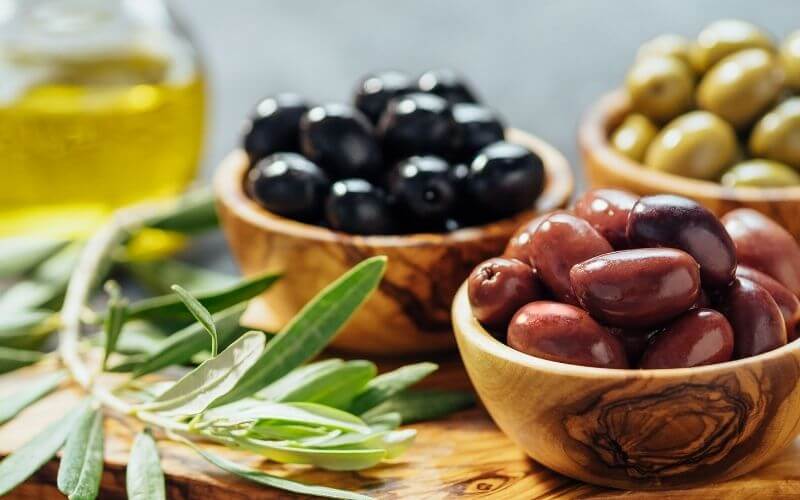
The dishes of Greece are as diverse as its stunning landscapes. Each region offers unique flavours that reflect its geography, climate, and cultural influences, with many of these culinary traditions tracing back to ancient Greece.
Influenced by its proximity to the Balkans and Turkey, Northern Greece is a haven for bold and hearty dishes. Try spetsofai, a rustic stew made with sausage and peppers, or indulge in bougatsa, a custard-filled pastry dusted with icing sugar and cinnamon.
Known for its olive groves and rich history, the Peloponnese is home to pastitsada, a spiced meat and pasta dish often made with rooster or beef. Be sure to sample Kalamata olives, prized for their rich, fruity flavour.
Greece’s islands are synonymous with fresh seafood and light, refreshing dishes. On the Cycladic islands, savour astakomakaronada (lobster pasta) and sample the famous cheeses of Naxos. The Dodecanese islands offer unique dishes like pitaroudia, chickpea fritters packed with herbs and spices.
Crete, Greece’s largest island, is known for its distinct culinary identity. The Cretan diet is considered one of the healthiest in the world, showcasing dishes like dakos, a salad of barley rusks topped with chopped tomatoes, feta, and olive oil, and Cretan honey, used in desserts and drinks.
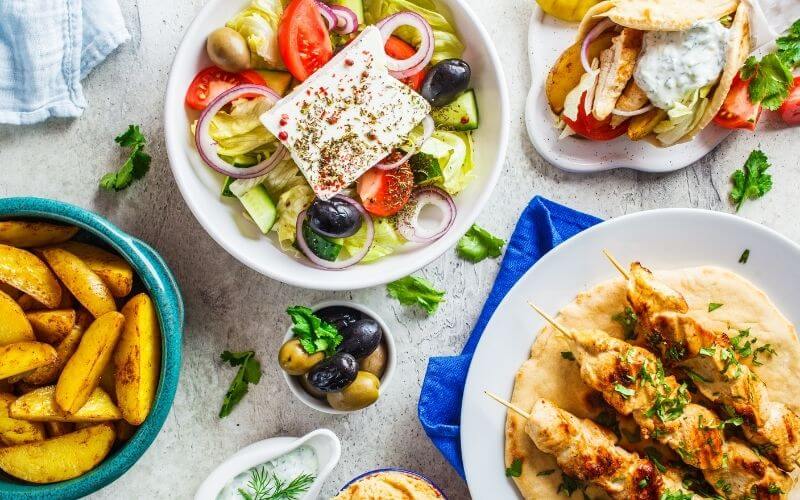
Dining in Greece is more than just a meal—it’s a celebration of life. Understanding Greek traditions food can enhance your culinary experience. When you visit a Greek taverna, you can expect a variety of starters and main dishes that showcase authentic Greek cuisine.
Traditional dishes like Tzatziki are commonly ordered, making the Greek taverna a focal point for enjoying the rich flavors and cultural heritage of Greece.
In Greece, meals are a communal affair. Whether at a family table or a taverna by the sea, food brings people together. Expect long meals filled with lively conversation, laughter, and perhaps a toast of ouzo or tsipouro.
Traditional Greek tavernas are the heart of the dining experience. Most menus feature a variety of mezze (small dishes) to share, house wine served in carafes, and freshly prepared seasonal specials. Be sure to ask for the day’s recommendations — they’re often the freshest options.
Greek cuisine revolves around fresh, local ingredients. In the Greek summer, you’ll find dishes bursting with ripe tomatoes and zucchini, like Moussaka and Gemista, which are quintessential representations of Greek summer cuisine. Winter menus highlight hearty stews and oven-baked casseroles.

Greek street food and fast food are known for their deliciousness and convenience. Some popular options include souvlaki, a classic Greek street food made with grilled meat skewers, often served with a side of tzatziki sauce and pita bread.
Gyros is another favourite, a popular Greek dish made with layers of meat cooked on a vertical spit and served in a pita bread with tomato, onion, and tzatziki sauce.
Greek meatballs are also a popular option, made with minced meat and served with a side of rich tomato sauce and pita bread. For a quick and easy meal, try a traditional Greek sandwich, made with grilled meat, vegetables, and tzatziki sauce, all served on a crusty bread roll. Fresh fish is also a staple of Greek street food, often served grilled or fried and accompanied by a side of lemon wedges and tartar sauce.

Athens is a city where every meal offers a chance to explore a rich culinary heritage. From iconic street food to lavish traditional feasts, there’s no shortage of delicious Greek foods to try.
As the capital, Athens is a culinary playground where ancient recipes coexist with modern gastronomy. Whether you’re sampling street food in bustling neighbourhoods or dining at Michelin-starred restaurants, Athens offers a feast for every traveller.
The Greek restaurant menu here is diverse, featuring everything from appetizers like Greek Fava to hearty main meals, showcasing the versatility and cultural significance of these dishes.
Koulouri: A sesame-covered bread ring, perfect for breakfast or a snack, sold by street vendors across the city.
Loukoumades: These honey-drizzled doughnuts are a favourite dessert in Athens.
Fava: A creamy yellow split pea purée, often served with olive oil and onions.

Top Restaurants and Food Neighbourhoods
Plaka and Monastiraki: These historic areas are home to traditional tavernas like Thanasis, known for its juicy souvlaki, and Bairaktaris, a local institution for gyros.
Psiri: A trendy neighbourhood blending the old and the new. Check out Oineas for creative takes on Greek classics or Tavern Klimataria, a charming spot with live music and hearty stews.
Varvakios Market: The central market of Athens offers an authentic experience of Greek ingredients, from fresh seafood to aromatic spices. Grab a quick bite at nearby eateries like Diporto, a hidden gem serving simple, rustic dishes in a basement setting.
Michelin-Starred Dining: For upscale options, try Funky Gourmet, which reimagines Greek cuisine with innovative presentations, or Spondi, known for its refined Mediterranean menu.

Renowned as Greece’s gastronomic hub, Thessaloniki combines local flavours with multicultural influences from the Balkans and the Ottoman Empire. This coastal city is a food lover’s paradise, offering a vibrant café culture, unparalleled pastries, and hearty dishes.
Signature Dishes in Thessaloniki
Bougatsa: A flaky pastry filled with custard, cheese, or minced meat, enjoyed as breakfast or a snack.
Trigona Panoramatos: Sweet, triangle-shaped phyllo pastries filled with creamy custard.
Soutzoukakia: Spiced meatballs in a rich tomato sauce, a dish introduced by refugees from Asia Minor.

Top Restaurants and Food Spots
Ladadika District: This lively area is packed with traditional tavernas and ouzeris (small eateries serving ouzo and mezze). Try Molyvos for authentic seafood dishes or Fulltou Meze for a variety of small plates.
Modiano Market: A historic market where you can sample local delicacies and buy spices, olives, and cheeses. Stop by a nearby café for a traditional Greek coffee.
Bougatsa Giannis: Famous for its bougatsa, this spot is a must-visit for pastry lovers.
Elaiolithos: A modern restaurant celebrating local ingredients with contemporary twists on traditional recipes.
Café Culture: Thessaloniki’s café scene is legendary. Visit To Palio Hamam for a unique atmosphere in a restored Ottoman bathhouse or Estrella for the city’s famed “bougatsan,” a croissant-bougatsa hybrid.
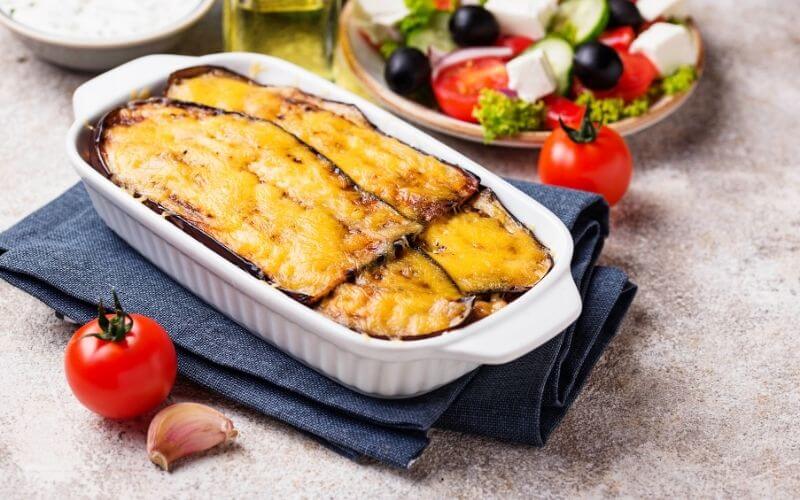
While cities like Athens and Thessaloniki are foodie hotspots, some of the best dishes to try in Greece can be found in less touristy areas.
For a truly authentic experience, head to small villages where recipes have been preserved for centuries. Visit local markets to sample fresh produce, artisanal cheeses, and homemade sweets.
Want to have a more hands-on experience? Want to dive deeper into the topics while enjoying different dishes? Join a food tour to discover hidden gems or take a cooking class to learn how to make Greek traditions food like moussaka or baklava.
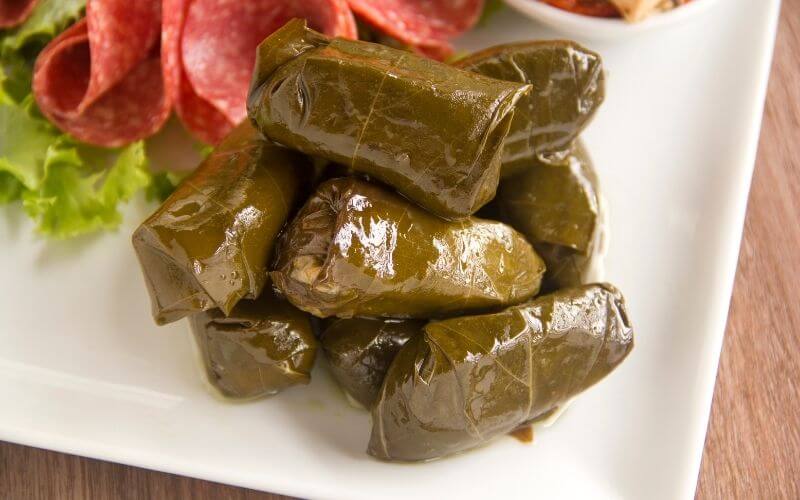
To make the most of your culinary adventure, here are a few practical tips:
Try local specialities: Each region has its own standout dishes. Don’t hesitate to ask the locals for recommendations.
Share mezze: Sampling a variety of small dishes is the best way to experience the flavours of Greece.
Don’t rush: Greek meals are meant to be savoured. Take your time and enjoy the relaxed pace of dining.
Embrace Street Food: Both cities offer delicious, affordable street eats like koulouri, souvlaki, and gyros.
Don’t Skip Breakfast: Start your day with bougatsa or a koulouri paired with strong Greek coffee.
Explore Local Markets: Visit Varvakios Market in Athens and Modiano Market in Thessaloniki to experience the heart of Greek food culture.
Try Regional Wines: Pair your meals with local wines like Assyrtiko or Xinomavro for a complete Greek dining experience.
Ask Locals for Recommendations: Some of the best spots are off the beaten path — locals are always happy to share their favourites.
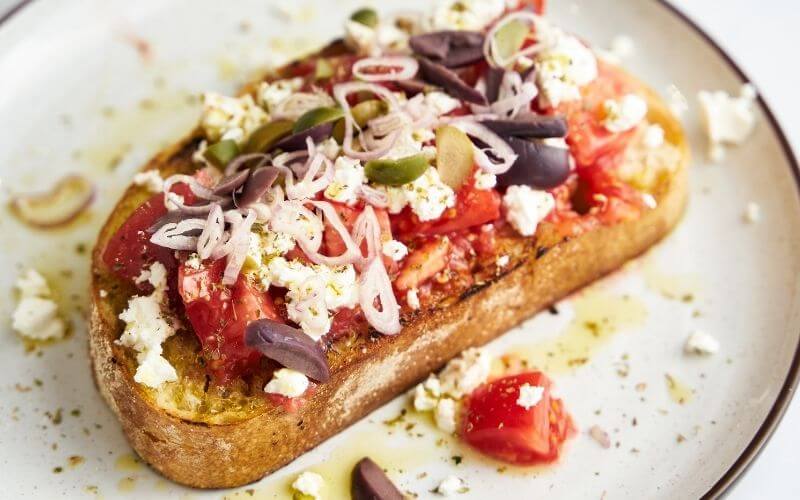
From the islands to the mainland, the most popular food in Greece offers a window into the country’s rich history and culture. Whether you’re savouring fresh seafood by the Aegean Sea, indulging in a hearty plate of moussaka, or enjoying mezze with friends, the dishes of Greece promise an unforgettable culinary journey.
So pack your bags, bring your appetite, and get ready to discover why Greek food is celebrated around the world.